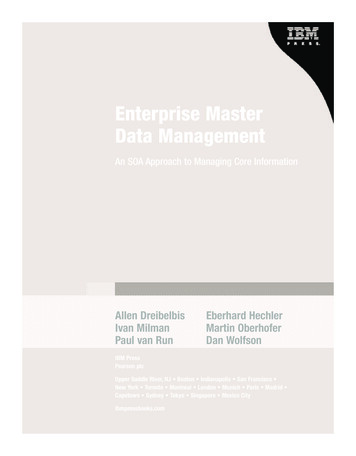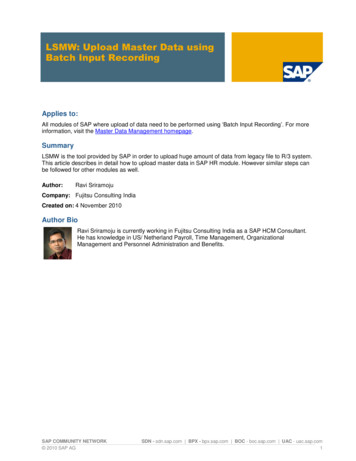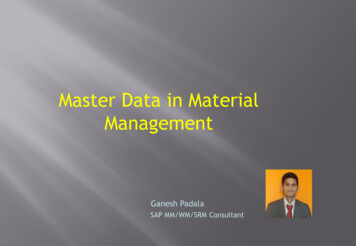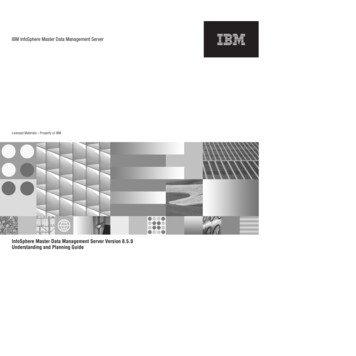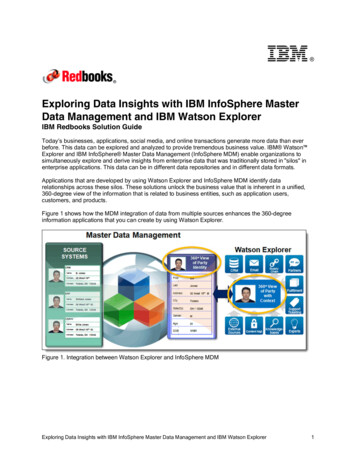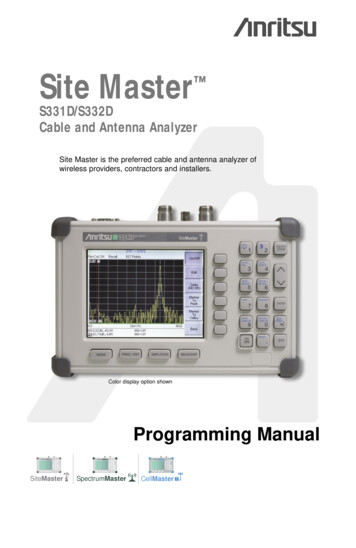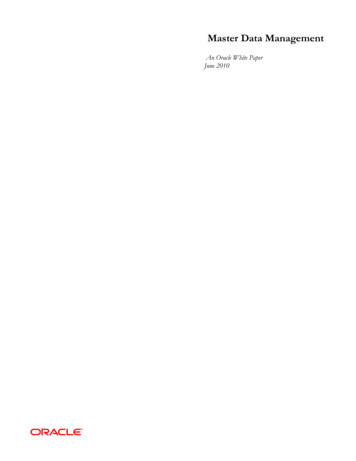
Transcription
Master Data ManagementAn Oracle White PaperJune 2010
Master Data ManagementIntroduction . 1Overview. 2Enterprise data . 4Transactional Data . 4Operational MDM . 5Analytical Data . 5Analytical MDM . 5Master Data . 5Enterprise MDM . 6Information Architecture . 6Operational Applications . 6Enterprise Application Integration (EAI) . 7Service Oriented Architecture (SOA) . 7The Data Quality Problem. 7Analytical Systems. 8Enterprise Data Warehousing (EDW) and Data Marts . 8Extraction, Transformation, and Loading (ETL). 9Business Intelligence (BI). 9The Data Quality Problem. 9Ideal Information Architecture . 10Oracle Information Architecture . 11Master Data Management Processes . 13Profile . 14Consolidate . 15Govern . 15Share . 15Leverage . 16Oracle MDM High Level Architecture . 16MDM Platform Layer . 17Application Integration Services . 17Enterprise Service Bus . 17Business Process Orchestration Services . 17Business Rules . 18Event-Driven Services . 19Identity Management. 19Web Services Management. 19Analytic Services . 20Enterprise Performance Management . 20Data Warehousing . 20Business Intelligence . 21Master Data Managementii
Publishing Services . 21Data Migration Services . 21High Availability and Scalability . 22Real Application Clusters . 22Mixed Workloads . 22Exadata . 22Application Integration Architecture . 23AIA Layers . 23Common Object Methodology . 24MDM Foundation Packs . 24MDM Process Integration Packs . 24MDM Aware Applications. 25Composite Application Development . 25Oracle Data Quality Services . 25Oracle Customer Data Quality Servers . 27Product Data Quality . 29End-To-End Data Quality . 31Application Development Environment . 32MDM Applications Layer . 32MDM Pillars . 32Oracle Customer Hub . 33Customer Data Model . 34Consolidate. 35Cleanse . 36Govern . 36Share . 38Business Benefits . 39Product Hub . 39Import Workbench . 40Catalog Administration . 41New Product Introduction . 41Product Data Synchronization . 41Oracle Site Hub . 42Golden Record for Site Data. 43Application Integration . 43Effective Site Analysis and Google Integration . 43Oracle Supplier Hub. 45Consolidate. 45Cleanse . 46Govern . 46Share . 46Supplier Lifecycle Management . 46Business Benefits . 46Oracle Hyperion Data Relationship Management . 47Automated Attribute Management . 48Best-of-Breed Hierarchy Management . 49Integration with Operational and Workflow Systems . 49Import, Blend, and Export to Synchronize Master Data . 49Versioning and Modeling Capabilities to Improve Analysis. 50Master Data Managementiii
MDM Data Governance and Industries Layer . 50MDM Industry Verticalization . 50Higher Education Constituent Hub. 50Product Hub for Retail . 51Product Hub for Communications . 51Data Governance . 52Data Watch and Repair for MDM . 53MDM Implementation Best Practices . 54Build vs Buy . 55Conclusion . 56Master Data Managementiv
Master Data ManagementINTRODUCTIONMany organizations are not realizing theanticipated ROI in their existingapplications.Oracle MDM helps organizations realizethe return on existing and new applicationinvestments.Fragmented inconsistent Product data slows time-to-market, creates supply chaininefficiencies, results in weaker than expected market penetration, and drives up thecost of compliance. Fragmented inconsistent Customer data hides revenuerecognition, introduces risk, creates sales inefficiencies, and results in misguidedmarketing campaigns and lost customer loyalty 1 . Fragmented and inconsistentSupplier data reduces supply chain efficiencies, negatively impacts spend controlinitiatives, and increases the risk of supplier exceptions. “Product”, “Customer”,and “Supplier” are only three of a large number of key business entities we refer toas Master Data.Master Data is the critical business information supporting the transactional andanalytical operations of the enterprise. Master Data Management (MDM) is acombination of applications and technologies that consolidates, cleans, andaugments this corporate master data, and synchronizes it with all applications,business processes, and analytical tools. This results in significant improvements inoperational efficiency, reporting, and fact based decision-making.Over the last several decades, IT landscapes have grown into complex arrays ofdifferent systems, applications, and technologies. This fragmented environment hascreated significant data problems. These data problems are breaking businessprocesses; impeding Customer Relationship Management (CRM), EnterpriseResource Planning (ERP), and Supply Chain Management (SCM) initiatives;corrupting analytics; and costing corporations billions of dollars a year. MDMattacks the enterprise data quality problem at its source on the operational side ofthe business. This is done in a coordinated fashion with the data warehousing /analytical side of the business. The combined approach is proving itself to be verysuccessful in leading companies around the world.“Through 2010, 70 percent of Fortune 1000organizations will apply MDM programs toensure the accuracy and integrity ofcommonly shared business information forcompliance, operational efficiency andcompetitive differentiation purposes (0.7probability).”GartnerThis paper will discuss what it means to ‘manage’ master data and outlines Oracle’sMDM solution 2 . Oracle’s technology components are ideal for building master datamanagement systems, and Oracle’s pre-built MDM solutions for key master dataobjects such as Product, Customer, Supplier, Site, and Financial data can bring realbusiness value in a fraction of the time it takes to build from scratch. Oracle’sMDM portfolio also includes tools that directly support data governance within themaster data stores. What’s more, Oracle MDM utilizes Oracle’s ApplicationIntegration Architecture to create MDM Aware Applications 3 and integrate thehigh quality authoritative master data into the IT landscape. This fusion ofCustomer Data Integration – Reaching a Single Version of the Truth, Jill Dyche, Evan Levy Wiley & Sons,20062 Oracle Master Data Management, an Oracle Data Sheet, URL3 MDM Aware Applications, an Oracle Whitepaper, URL1
applications and technology creates a solution superior to other MDM offerings onthe market.OVERVIEWHigh quality customer information wascritically important for Areva’s deploymentof major new application suites, includingSCM and CRM. Oracle Customer Hubprovided the unique customer databasethat can be shared by all applicationsmanaging customer data and the criticaldata quality tools needed to increase ourcustomer knowledge. With OracleCustomer Hub at the center of the Areva ITlandscape, customer data is collected fromall relevant applications, harmonized,merged, enriched with D&B data, andpublished to operational and analyticalsystems. ROI has been measured at 38%over 4 years with a 37 month payback.Florence Legacy, Project ManagerBruno Billy, Data ManagerAreva T&DHow do you get from a thousand points of data entry to a single view of thebusiness? This is the challenge that has faced companies for many years. ServiceOriented Architecture (SOA) is helping to automate business processes acrossdisparate applications, but the data fragmentation remains. Modern businessanalytics on top of terabyte sized data warehouses are producing ever more relevantand actionable information for decision makers, but the data sources remainfragmented and inconsistent. These data quality problems continue to impactoperational efficiency and reporting accuracy. Master Data Management is the key.It fixes the data quality problem on the operational side of the business andaugments and operationalizes the data warehouse on the analytical side of thebusiness. In this paper, we will explore the central role of MDM as part of acomplete information management solution.Master Data Management has two architectural components: The technology to profile, consolidate and synchronize the master dataacross the enterprise The applications to manage, cleanse, and enrich the structured andunstructured master dataMDM must seamlessly integrate with modern Service Oriented Architectures inorder to manage the master data across the many systems that are responsible fordata entry, and bring the clean corporate master data to the applications andprocesses that run the business.“The master data management systemgave us a single, integrated view of ourcustomers, partners, and suppliers. Theinformation helps us run our businessmore effectively and ensures we makesound decisions.”Kim Hyoung-soo, Section ChiefProcess Innovation Team, MDM SectionHanjin ShippingMDM becomes the central source for accurate fully cross-referenced real timemaster data. It must seamlessly integrate with data warehouses, EnterprisePerformance Management (EPM) applications, and all Business Intelligence (BI)systems, designed to bring the right information in the right form to the rightperson at the right time.In addition to supporting and augmenting SOA and BI systems, the MDMapplications must support data governance. Data Governance is a business processfor defining the data definitions, standards, access rights, quality rules. MDMexecutes these rules. MDM enables strong data controls across the enterprise.In order to successfully manage the master data, support corporate governance, andaugment SOA and BI systems, the MDM applications must have the followingcharacteristics: A flexible, extensible and open data model to hold the master data and allneeded attributes (both structured and unstructured). In addition, the datamodel must be application neutral, yet support OLTP workloads anddirectly connected applications. A metadata management capability for items such as business entitymatrixed relationships and hierarchies.Master Data Management2
A source system management capability to fully cross-reference businessobjects and to satisfy seemingly conflicting data ownership requirements. A data quality function that can find and eliminate duplicate data whileinsuring correct data attribute survivorship. hA data quality interface to assist with preventing new errors fromentering the system even when data entry is outside the MDM applicationitself. A continuing data cleansing function to keep the data up to date. An internal triggering mechanism to create and deploy change informationto all connected systems. A comprehensive data security system to control and monitor data access,update rights, and maintain change history. A user interface to support casual users and data stewards. A data migration management capability to insure consistency as datamoves across the real time enterprise. A business intelligence structure to support profiling, compliance, andbusiness performance indicators. A single platform to manage all master data objects in order to prevent theproliferation of new silos of information on top of the existingfragmentation problem. An analytical foundation for directly analyzing master data. A highly available and scalable platform for mission critical data accessunder heavy mixed workloads.Oracle’s market leading MDM solutions have all of these characteristics. With thebroadest set of operational and analytical MDM applications in the industry, OracleMDM is designed to support Governance, Risk mitigation, and Compliance (GRC)by eliminating inconsistencies in the core business data across applications andenabling strong process controls on a centrally managed master data store.Master Data Management3
This paper examines: the nature of master data; MDM’s central role in SOA and BIsystems; the Oracle MDM Architecture; key MDM processes of profiling,consolidating, managing, synchronizing, and leveraging master data and how theOracle MDM solution supports these processes; and Oracle’s portfolio of pre-builtmaster data management solutions. Finally, this paper discusses build vs. buytradeoffs given the power and flexibility in the Oracle MDM architecture and outof-the-box capabilities of the pre-built and pre-connected MDM Hubs.ENTERPRISE DATAAn enterprise has three kinds of actual business data: Transactional, Analytical, andMaster. Transactional data supports the applications. Analytical data supportsdecision-making. Master data represents the business objects upon whichtransactions are done and the dimensions around which analysis is accomplished.Types of Data in the aAnalyticalData Describes an Enterprise’sOperational State Describes an Enterprise’sBusiness Entities Describes an Enterprise’sPerformanceAs data is moved and manipulated, information about where it came from, whatchanges it went through, etc. represents a fourth kind of enterprise data calledmetadata (data about the data). Though not a prime focus of this paper, the keyrole metadata plays in the broader information management space and how itrelates directly to MDM is described.Transactional DataA company’s operations are supported by applications that automate key businessprocesses. These include areas such as sales, service, order management,manufacturing, purchasing, billing, accounts receivable and accounts payable. Theseapplications require significant amounts of data to function correctly. This includesdata about the objects that are involved in transactions, as well as the transactiondata itself. For example, when a customer buys a product, the transaction ismanaged by a sales application. The objects of the transaction are the Customerand the Product. The transactional data is the time, place, price, discount, paymentmethods, etc. used at the point of sale. The transactional data is stored in OnLineTransaction Processing (OLTP) tables that are designed to support high volumelow latency access and update.Master Data Management4
Operational MDMSolutions that focus on managing transactional data under operational applicationsare called Operational MDM. They rely heavily on integration technologies. Theybring real value to the enterprise, but lack the ability to influence reporting andanalytics.Analytical DataAnalytical data is used to support a company’s decision making. Customer buyingpatterns are analyzed to identify churn, profitability, and marketing segmentation.Suppliers are categorized, based on performance characteristics over time, forbetter supply chain decisions. Product behavior is scrutinized over long periods toidentify failure patterns. This data is stored in large Data Warehouses and possiblysmaller data marts with table structures designed to support heavy aggregation, adhoc queries, and data mining. Typically the data is stored in large fact tablessurrounded by key dimensions such as customer, product, supplier, account, andlocation.Analytical MDMSolutions that focus on managing analytical master data are called Analytical MDM.They focus on providing high quality dimensions with their multiple simultaneoushierarchies to data warehousing and BI technologies. They also bring real value tothe enterprise, but lack the ability to influence operational systems. Any datacleansing done inside an Analytical MDM solution is invisible to the transactionalapplications and transactional application knowledge is not available to thecleansing process. Because Analytical MDM systems can do nothing to improve thequality of the data under the heterogeneous application landscape, poor qualityinconsistent domain data finds its way into the BI systems and drives less thanoptimum results for reporting and decision making.Master DataMaster Data represents the business objects that are shared across more than onetransactional application. This data represents the business objects around whichthe transactions are executed. This data also represents the key dimensions aroundwhich analytics are done. Master data creates a single version of the truth aboutthese objects across the operational IT landscape.An MDM solution should to be able to manage all master data objects. Theseusually include Customer, Supplier, Site, Account, Asset, and Product. But otherobjects such as Invoices, Campaigns, or Service Requests can also crossapplications and need consolidation, standardization, cleansing, and distribution.Different industries will have additional objects that are critical to the smoothfunctioning of the business.It is also important to note that since MDM supports transactional applications, itmust support high volume transaction rates. Therefore, Master Data must reside indata models designed for OLTP environments. Operational Data Stores (ODS) donot fulfill this key architectural requirement.Master Data Management5
Enterprise MDMMaximum business value comes from managing both transactional and analyticalmaster data. These solutions are called Enterprise MDM. Operational datacleansing improves the operational efficiencies of the applications themselves andthe business process that use these applications. The resultant dimensions foranalytical analysis are true representations of how the business is actually running.What’s more, the insights realized through analytical processes are made availableto the operational side of the business.Oracle provides the most comprehensive Enterprise MDM solution on the markettoday. The following sections will illustrate how this combination of operations andanalytics is achieved.INFORMATION ARCHITECTUREThe best way to understand the role that MDM plays in an enterprise is tounderstand the typical IT landscape. The best place to start is with the applications.Almost all companies have a heterogeneous set of applications. Some are homegrown, others are bought from vendors, and still others are inherited duringcorporate mergers and acquisitions.Operational ApplicationsThe figure on the right illustrates thetypical heterogeneous operationalapplication situation. Transactionaldata exists in the applications localdata store. The data is designedspecifically to support the featuresand transaction rates needed by theapplication. This is as it should be.But, in order to support businessprocesses that cross these applicationboundaries, the data needs to besynchronized.The n2 Integration inancialsPartnersSupply ChainOrder ManagementHeterogeneous Application LandscapeApplicationsSalesM arketingServiceInventoryFinancialsPartnersSupply ChainOrder M anagementIntegration is an n2 problem in thatcomplexity grows geometrically withthe number of applications. Somecompanies have been known to calltheir data center connection diagrama “hair ball”. When synchronizationis accomplished with code, ITprojects can grind to a halt and thecosts quickly become prohibitive.This problem literally drove thecreation of Enterprise ApplicationIntegration (EAI) technologyMaster Data Management6
Enterprise Application Integration (EAI)EAI uses a metadata driven approach to synchronizing the data across theoperational applications. All information about what data needs to move, when itneeds to move, what transformations to execute as it moves, what error recoveryprocesses to use, etc. is stored in the metadata repository of the EAI tool.This information along withapplication connecters is used at runtime for needed synchronization.Hub and Spoke, Publish andSubscribe, high volume, low latencycontent based routing are keyfeatures of an EAI solution. Thefigure on the right illustrates a set ofapplications integrated via an EAItechnology. Depending on thetopology deployed, theseconfigurations are sometimes calledan enterprise service bus orintegration hub.Enterprise Application oryFinancialsPartnersSupply ChainOrder ManagementEAIService Oriented Architecture (SOA)In an SOA environment, the features and functions of the applications are exposedas shared services using standardized interfaces.Service Oriented ArchitectureOrchestrationApplicationsThese services can then be combinedin end-to-end business processes bya technique called Business ProcessOrchestration.In the figure on the left, we haveadded a business processorchestration layer to thearchitecture. This layer representsthe tools used to design and deploybusiness processes inancialsPartnersSupply ChainOMEAIThe implication for MDM is that itmust not only support application toapplication (A2A) integration, it mustalso expose the master data tothe business process orchestration layer as well. This is discussed in more depth ina later section.The Data Quality ProblemEAI and SOA dramatically reduce the cost of integration but leave the data silosuntouched. They are not designed to know what data ought to populate thevarious connected systems. They are designed to deal with the fragmentation, butMaster Data Management7
cannot eliminate it. All the data quality problems that existed in the pre-EAI/SOAenvironment still remain. Those problems continue to negatively impact businessprocesses that cross these application boundaries.Business Process Optimization (BPO) is acommon IT initiative. Optimizing businessprocesses can save millions of dollars ayear.For example, an Order to Cash process may involve sales, inventory, ordermanagement and accounts receivable applications. While the data in each of theapplications may be of sufficient quality to support the application, it may not begood enough to support the cross application business process. Product Ids andcustomer names may not be the same in each system. Which name or which Id iscorrect (if any). EAI and SOA are not designed to deal with these issues. A singleview of the business remains elusive.MDM is the solution to this problem. In fact, Forrester 4 considers MDM the most“strategic entry point for SOA” bringing the most strategic value to the business.But the anticipated improvements are never realized when data quality issuesabound in the underlying applications. In fact, Gartner 5 has pointed out that,without quality data, “ SOA will become a veritable ‘Pandora’s box’ ofinformation chaos within the enterprise.” Oracle MDM insures that the potentialvalue of SOA deployments is achieved.Analytical SystemsMany companies turned to data warehousing to create a single view of the truth.Since the 1980s, data models have been deployed to relational databases withbusiness intelligence features holding large amounts of historical data in schemadesigned for complex queries, heavy aggregation, and multiple table joins.This analytical space has three key components:1.The Data Warehouse and subsidiary Data Marts2.Tools to Extract data from the operational systems, Transform it for thedata warehouse, and Load it into the data warehouse (ETL)3.Business Intelligence tools to analyze the data in the data warehouseThe following sections discuss these areas, and identify their MDM implications.Enterprise Data Warehousing (EDW) and Data MartsThe Enter
Feb 07, 2003 · Master Data is the critical business information supporting the transactional and analytical operations of the enterprise. Master Data Management (MDM) is a combination of applications and technologies that consolidates, cleans, and augments this corporate master
